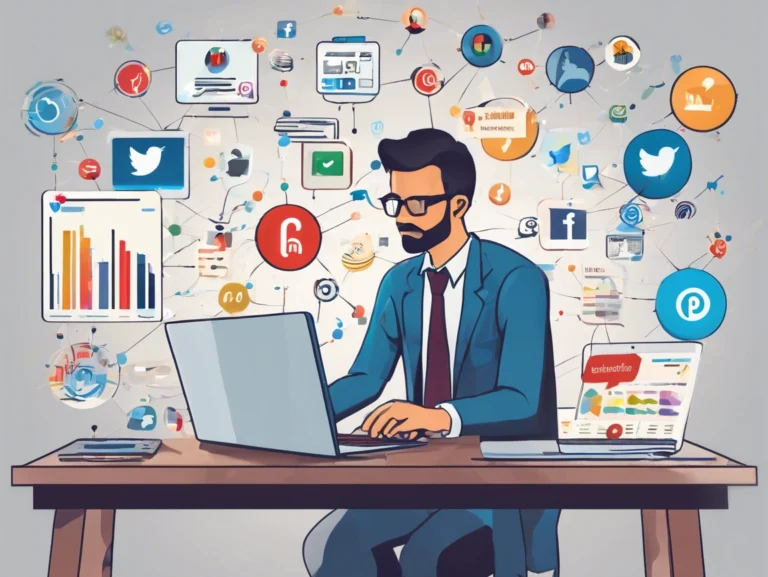The marketing technology (martech) industry evolves at rapid speed, with new martech trends constantly emerging and transforming the field. It is crucial to keep an eye on cutting-edge technologies and the newest approaches to improve your marketing strategy and martech stack. Business owners who are ready to embrace innovation will always end up with a competitive market advantage and better conversion rates. So, let’s take a look at the state of the martech industry today and talk about key trends that will shape the future of marketing in 2025.
About Martech
Martech is a range of software and digital tools that assist organizations in achieving their marketing goals and objectives. Technologies that marketing teams utilize for streamlining, automating, or measuring marketing activities are also known as the martech stack.
Marketing technology has been around since the 1990s With the growth of social media and digital advertising platforms in the 2000s, the sector expanded at a rapid speed. In 2023, there were around 1,000 martech solutions available. According to reports, by 2032, the marketing technology industry is anticipated to generate $ 1.7 trillion.
The importance of martech in the current business landscape can’t be overstated. Marketing technologies provide companies with highly valuable data-driven insights about their customers, allow them to automate and streamline various routine and repetitive tasks, offer tools for delivering personalized and tailored campaigns, and play a critical role in gaining competitive advantage.
Trends in Marketing Technology for 2025
With new marketing technology constantly emerging, it is essential for your business success to stay on top of these innovations, create immersive customer experiences, and enhance user engagement. Whether you develop a marketing solution in-house or cooperate with a martech development company, comprehensive knowledge of cutting-edge technologies is a must. Let’s talk about the main digital marketing technology trends to pay attention to in 2025.
Artificial Intelligence (AI) and Machine Learning (ML)
Further Reading: 33 Leading AI Marketing Tools to Explore
Chatbots and Conversational Marketing
Conversational marketing fundamentally changed how businesses engage with customers in recent years, and the adoption of chatbots played a critical role in this shift. Today, using the power of AI, chatbots can understand and respond to humans more accurately than ever due to enhanced Natural Language Processing (NLP) capabilities and provide highly personalized recommendations based on past user behavior and interactions.
Modern chatbots are actively used in omnichannel marketing and are implemented in websites, social media platforms, messengers, and email campaigns. Among the significant advantages of the adoption of chatbots are 24/7 availability, instant responses, and automated responses to routine queries, which frees up more time for human customer service employees to deal with more complex issues.
Conversational marketing strategy allows companies to build stronger relationships with users, create more personalized customer experiences, generate more leads with an AI-powered approach, and collect more valuable data about user behaviors and current market trends. These advantages make it one of the biggest technology trends in marketing today. In the near future, we will likely see more voice-enabled and AR-integrated chatbots, making them even more easy-to-use and important for overall marketing strategy.
Video-First Marketing
The wide availability of high-speed internet and the popularity of social media platforms led to the increased popularity of video content. Today, videos are considered one of the most powerful and engaging forms of communication with customers, especially in marketing for tech companies. Video content is very versatile, varying in format and style from Reels and TikTok to longer YouTube videos, which makes them a perfect tool for conveying complex ideas to prospective customers or demonstrating product features in a visually appealing manner, which is especially useful for IT marketing.
Today, even small startups can create high-quality video content due to more accessible and affordable production tech. Digital online marketing professionals develop different content plans for different platforms to maximize reach and user engagement. Also, today, SEO optimization for videos, especially on YouTube, is critical for visibility. Advanced analytics and various metrics on modern platforms allow companies to understand content performance and effectiveness better, assess the return on investment, and allocate resources more effectively in the future.
In 2025, videos will continue to be one of the most important marketing technology trends for increasing brand awareness and engaging users. However, with visual content saturation, it will become more and more difficult to stand out and make a lasting impression, forcing marketing specialists to develop more creative and innovative strategies and keep up with current trends and user preferences in video consumption.
Further Reading: Which is the Best Video Editing App? Choose from These 17
SSP and DSP Integration
The integration of Supply-Side Platforms and Demand-Side Platforms led to significant advancements in martech and is rightfully considered one of the biggest technological trends in marketing. To better understand their importance, let’s talk about these platforms’ roles:
- Supply-Side Platforms (SSPs). These online platforms are used by publishers and media companies for managing, selling, and optimizing their available digital ad inventory. SSPs allow publishers to maximize revenue from their inventory, enabling them to set rules and preferences to ensure effective monetization. Supply-side platforms also provide real-time analytics and reports for a better understanding of inventory performance.
- Demand-Side Platforms (DSPs). These platforms are used by advertisers and ad agencies for purchasing and managing digital inventory. DSPs primary function is to assist advertisers in identifying and targeting specific audiences, optimizing digital marketing campaigns, and allocating advertising budgets. Demand-Side Platforms provide advertisers with tools for monitoring campaign performance, setting targeting parameters, and bidding on inventory in real-time.
The integration of both platforms brings numerous benefits for companies that operate in the technology advertising business landscape. It creates a more streamlined process for both publishers and advertisers, improves ad performance, and increases transparency in pricing, audience data, and performance metrics. In 2025, companies will continue to actively use these platforms to optimize their ad budgets and achieve marketing objectives. Advancements in AI and ML will likely enhance the automation and efficiency of integrated SDPs and SSPs.
Virtual Reality (VR) and Augmented Reality (AR)
VR and AR technologies have taken a prominent place in the martech landscape in recent years and, in 2025, will continue to gain significant traction. The rising popularity of these new technologies in marketing provided companies with new, exciting possibilities for creating engaging and compelling advertising campaigns.
VR is widely used for virtual tours, product demonstrations, trade shows, and creating immersive customer journeys. AR technology allows customers to easily visualize products in real-world environments, elevating the shopping experience and leading to higher conversion rates. Both technologies become more and more accessible due to hardware and software improvements. Today, most mobile devices support VR and VR elements, and AI implementation provides more relevant and personalized experiences.
Trying to Keep Up with Digital Marketing?
Just released: my new book to help small businesses, entrepreneurs, and marketers master digital marketing in today’s digital-first world.
Drawing on my Fractional CMO experience, Digital Threads simplifies complex strategies into clear, actionable steps for success.
Transform your business today—grab your copy! Click the cover or button below to buy on Amazon.
Professionals expect the blending of VR and AR into Mixed Reality (MR) in the near future, which will result in even more creative and immersive experiences for customers. Also, AR is expected to rise in popularity and fully break into mainstream marketing campaigns. While VR still requires special hardware, Augmented Reality experiences are more affordable, and this technology is more likely to become one of the main trends in martech.
Further Reading: AI and Virtual Influencers: What is Their Role in Influencer Marketing? (with examples)
Multilingual Marketing
With an increasingly global business landscape, multilingual marketing is becoming one of the most prominent digital marketing trends, essential for effectively communicating with potential customers across different languages and cultures. Multilingual marketing goes beyond simple translation; it requires thorough localization of marketing content. In collaboration with native speakers, companies need to adapt their resources considering different nuances, idioms, and cultural references.
By using multilingual marketing, businesses can reach much wider and diverse audiences and gain a competitive advantage in markets where competitors don’t have multilingual capabilities. Thorough localization enables companies to build strong connections with foreign customers and convey their marketing messages more accurately. Implementing SEO strategies for different languages can enhance search engine rankings and capture organic traffic from different regions.
AI-powered translation tools made a multilingual approach more efficient, but it still requires human oversight. In the near future, the integration of more advanced AI and ML algorithms in translation and customer data analysis will increase the effectiveness of marketing efforts. Meanwhile, with the continuous growth of global interconnectivity, multilingual marketing will continue to shape the future of marketing.
Further Reading: The 21 Best Social Listening Tools to Monitor and Empower Your Marketing
No-Code Technology
The adoption of no-code technology has been transformative for the marketing industry in 2023 and will continue to play a vital role in 2025. No-code platforms empower users with little to no programming experience to build, customize, and even automate IT solutions. Today, thanks to this innovation, marketing managers can create apps, websites, landing pages, and marketing campaigns through easy-to-use interfaces without relying on tech experts.
The rising popularity of this new technology in marketing has many significant advantages, such as faster prototyping and deployment of martech solutions, lower development time and reduced costs, and the ability to experiment with marketing strategies without considerable investments easily.
But no-code platforms still have their limitations and setbacks. With no-code solutions, companies can’t build large-scale digital products due to limited scalability and performance. Also, no-code technology is not great for customization and offers little flexibility, which is crucial for niche and complex solutions. In the future, no-code platforms are expected to evolve and benefit from various integrations, including AI and AR technologies.
Further Reading: 13 Social Media Trends You Need to Understand in 2025
Privacy-Focused Marketing
With growing data privacy concerns and changes in data protection regulations, marketing specialists have started to prioritize customer privacy in their campaigns and martech platforms. This approach involves transparent data practices, reliance on first-party and zero-party data, and building trust with users.
Today, organizations are way more transparent about how they collect, use, and store customer data. Clear communication and enhanced security measures are essential to build trust with consumers. Also, companies are shifting away from third-party cookies towards first-party data gathered directly from users based on their interactions and preferences. Zero-party data refers to information that customers provide willingly, making marketing more transparent and consent-driven.
In the next few years, finding the perfect balance between a high level of personalization and respect for user privacy will become the main challenge for marketing professionals worldwide. Privacy-enhancing technologies, such as secure multi-party computation and differential privacy, will allow organizations to analyze customer data without compromising privacy. With consumers becoming more concerned with their rights, privacy-focused marketing will be even more critical for building trust with users and increasing customer loyalty in the near future. We can expect that in the era of strict privacy regulations, the importance of zero-party data gathering will continue to grow and in 2025 it will become more widely known and used by companies from all around the world in their marketing technology strategies.
Conclusion
Marketing technologies are crucial for business success today. The martech industry provides organizations with advanced marketing tools and platforms for collecting and processing user data, gaining valuable insights, predicting future market trends, developing effective digital marketing strategies, and building stronger relationships with customers. Staying up to date with current and future trends in marketing technology is a critical driver of success in our digital age. Embrace cutting-edge technologies and approaches to gain a competitive advantage and drive your number up.
This is a post contributed from one of my marketing partners.














